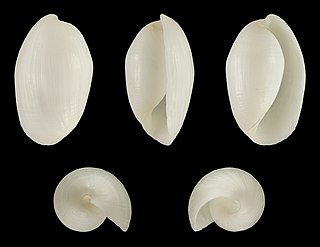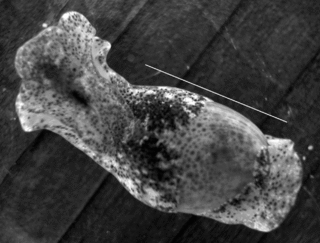
The order Cephalaspidea, also known as the headshield slugs and bubble snails, is a major taxon of sea slugs and bubble snails, marine gastropod mollusks within the larger clade Euopisthobranchia. Bubble shells is another common name for these families of marine gastropods, some of which have thin bubble-like shells. This clade contains more than 600 species.

Acteonidae, common name the "barrel bubble snails", is a family of small sea snails, marine gastropod mollusks of the informal group Lower Heterobranchia.

The Aplustridae is a taxonomic family of sea snails or bubble snails, marine gastropod mollusks in the superfamily Acteonoidea.

Bulla is a genus of medium to large hermaphrodite sea snails, shelled marine opisthobranch gastropod molluscs. These herbivorous snails are in the suborder Cephalaspidea, headshield slugs, and the order Opisthobranchia.
Diaphanoidea is a taxonomic superfamily of small sea snails, marine opisthobranch gastropod mollusks or micromollusks in the Cephalaspidea, the headshield slugs and bubble snails.

Haminoeidae, commonly known as the haminoeid bubble snail family, is a taxonomic family of sea snails, marine opisthobranch gastropod mollusks in the superfamily Haminoeoidea.

Aliculastrum is a genus of small sea snails or bubble snails, marine opisthobranch gastropod molluscs in the family Haminoeidae.

Atys is a genus of very small to medium-sized sea snails, marine opisthobranch gastropod mollusks in the family Haminoeidae.

Planorbidae, common name the ramshorn snails or ram's horn snails, is a family of air-breathing freshwater snails, aquatic pulmonate gastropod molluscs. Unlike most molluscs, the blood of ram's horn snails contains iron-based hemoglobin instead of copper-based hemocyanin. As a result, planorbids are able to breathe oxygen more efficiently than other molluscs. The presence of hemoglobin gives the body a reddish colour. This is especially apparent in albino animals.

Papawera zelandiae, common name the white bubble shell, is a species of medium-sized sea snail or bubble snail, a marine opisthobranch gastropod mollusc in the family Haminoeidae, the bubble snails.

Acteon is a genus of small sea snails, predatory marine gastropod mollusks in the family Acteonidae, the barrel bubble snails.

Haminoea is a genus of medium-sized sea snails or bubble snails, marine opisthobranch gastropod molluscs in the family Haminoeidae, the haminoea bubble snails, part of the clade Cephalaspidea, the headshield slugs and bubble snails.

Haloa japonica, common name the Japanese bubble snail, is a species of sea snail or bubble snail, a marine opisthobranch gastropod mollusc in the family Haminoeidae, one of the families of bubble snails.

Bullacta exarata, common name the Korean mud snail, is a species of a sea snail or bubble snail, a marine gastropod mollusc in the family Haminoeidae, the bubble snails.

Lamprohaminoea cymbalum, sometimes known as the Cymbal bubble snail, is a species of sea snail or bubble snail, a marine opisthobranch gastropod mollusc in the family Haminoeidae, one of the families of bubble snails.

Haminoea natalensis, common name the South African bubble snail, is a species of sea snail or bubble snail, a marine opisthobranch gastropod mollusc in the family Haminoeidae, one of the families of bubble snails.

Tornatinidae is a family of very small sea snails, barrel-bubble snails, marine opisthobranch gastropod molluscs. These are headshield slugs, in the superfamily Bulloidea.

Smaragdinella is a genus of medium-sized sea snails or bubble snails, marine opisthobranch gastropod molluscs in the family Haminoeidae, the haminoea bubble snails, part of the clade Cephalaspidea, the headshield slugs and bubble snails.

Phanerophthalmus is a genus of medium-sized sea snails or bubble snails, marine opisthobranch gastropod molluscs in the family Haminoeidae, the haminoea bubble snails, part of the clade Cephalaspidea, the headshield slugs and bubble snails.

Smaragdinella calyculata, also called calyx bubble shell, is a small shelled slug common on rocky shores in the Indo-Pacific including Hawaii.


















